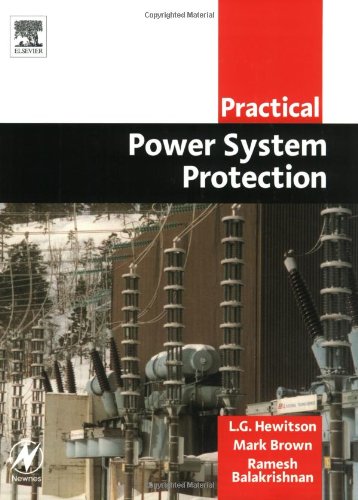Leslie Hewitson, Mark Brown, Ramesh Balakrishnan0750663979, 9780750663977
Table of contents :
Cover……Page 1
Half Title Page……Page 2
Other titles in the series……Page 3
Title Page……Page 4
Copyright……Page 5
Contents……Page 6
Preface……Page 10
1.1 Need for protective apparatus……Page 12
1.3 Basic components of protection……Page 13
1.4 Summary……Page 14
2.1 The development of simple distribution systems……Page 16
2.2 Fault types and their effects……Page 18
3.2 Revision of basic formulae……Page 22
3.3 Calculation of short-circuit MVA……Page 26
3.4 Useful formulae……Page 29
3.5 Cable information……Page 33
3.6 Copper conductors……Page 36
4.1 Introduction……Page 37
4.2 Earthing devices……Page 38
4.3 Evaluation of earthing methods……Page 41
4.4 Effect of electric shock on human beings……Page 43
5.2 Rewireable type……Page 46
5.4 Operating characteristics……Page 47
5.5 British standard 88:1952……Page 48
5.7 Application of selection of fuses……Page 49
5.8 General ‘rules of thumb’……Page 50
5.10 General……Page 51
5.11 Is-limiter……Page 53
6.2 Basic theory of operation……Page 56
6.3 Voltage transformers……Page 57
6.4 Current transformers……Page 65
6.5 Application of current transformers……Page 76
6.6 Introducing relays……Page 77
6.7 Inverse definite minimum time lag (IDMTL) relay……Page 78
7.2 Protective relay—circuit breaker combination……Page 81
7.3 Purpose of circuit breakers (switchgear)……Page 82
7.4 Behavior under fault conditions……Page 84
7.6 Types of circuit breakers……Page 85
7.7 Comparison of breaker types……Page 92
8.1 Tripping batteries……Page 94
8.2 Construction of battery chargers……Page 99
8.3 Maintenance guide……Page 100
8.4 Trip circuit supervision……Page 103
8.5 Reasons why breakers and contactors fail to trip……Page 104
8.6 Capacitor storage trip units……Page 105
9.2 Principle of the construction and operation of the electromechanical IDMTL relay……Page 107
9.4 The new era in protection — microprocessor vs electronic vs traditional……Page 118
9.5 Universal microprocessor overcurrent relay……Page 125
9.6 Technical features of a modern microprocessor relay……Page 127
9.7 Type testing of static relays……Page 135
9.8 The future of protection for distribution systems……Page 136
9.9 The era of the IED……Page 137
9.10 Substation automation……Page 140
9.11 Communication capability……Page 143
10.1 Protection design parameters on medium- and low-voltage networks……Page 144
10.2 Sensitive earth fault protection……Page 159
11.2 Air circuit breakers……Page 161
11.3 Moulded case circuit breakers……Page 162
11.4 Application and selective coordination……Page 171
11.5 Earth leakage protection……Page 176
12.1 General……Page 180
12.2 Earth-leakage protection……Page 181
12.3 Pilot wire monitor……Page 183
12.5 Neutral earthing resistor monitor (NERM)……Page 184
13.3 Back-up protection……Page 192
13.5 Differential protection……Page 193
13.8 Feeder pilot-wire protection……Page 196
13.11 Advantages of unit protection……Page 197
14.2 Translay (see Figure 14.1)……Page 199
14.3 Solkor protection……Page 200
14.4 Distance protection……Page 203
15.2 Transformer connections……Page 218
15.3 Transformer magnetizing characteristics……Page 220
15.4 In-rush current……Page 221
15.5 Neutral earthing……Page 222
15.6 On-load tap changers……Page 223
15.7 Mismatch of current transformers……Page 224
15.8 Types of faults……Page 225
15.9 Differential protection……Page 227
15.10 Restricted earth fault……Page 231
15.11 HV overcurrent……Page 235
15.12 Buchholz protection……Page 237
15.13 Overloading……Page 238
16.1 Importance of busbars……Page 244
16.4 Busbar protection types……Page 245
17.1 Introduction……Page 255
17.2 Early motor protection relays……Page 258
17.3 Steady-state temperature rise……Page 259
17.5 Motor current during start and stall conditions……Page 260
17.6 Stalling of motors……Page 261
17.7 Unbalanced supply voltages……Page 262
17.9 Derating due to unbalanced currents……Page 264
17.10 Electrical faults in stator windings earth faults phase–phase faults……Page 265
17.11 General……Page 267
17.12 Typical protective settings for motors……Page 268
18.1 Introduction……Page 269
18.2 Stator earthing and earth faults……Page 270
18.6 Unbalanced loading……Page 272
18.7 Rotor faults……Page 273
18.12 Industrial generator protection……Page 275
18.13 Numerical relays……Page 276
18.14 Parallel operation with grid……Page 277
19.2 Schedule A……Page 278
19.3 Schedule B……Page 279
19.4 Test sheets……Page 280
Index……Page 285

Reviews
There are no reviews yet.